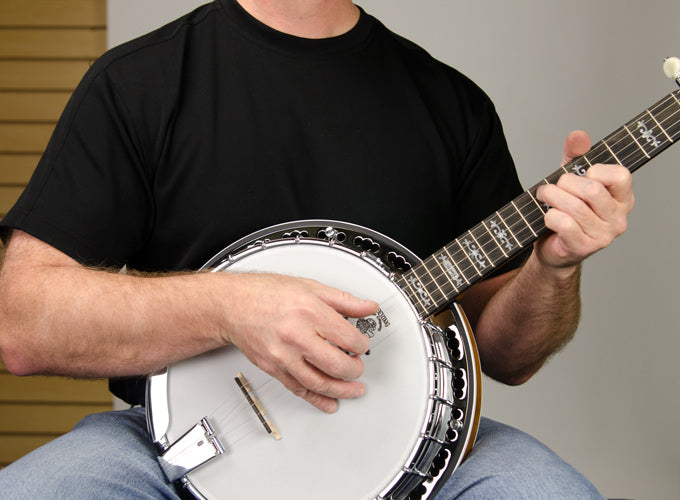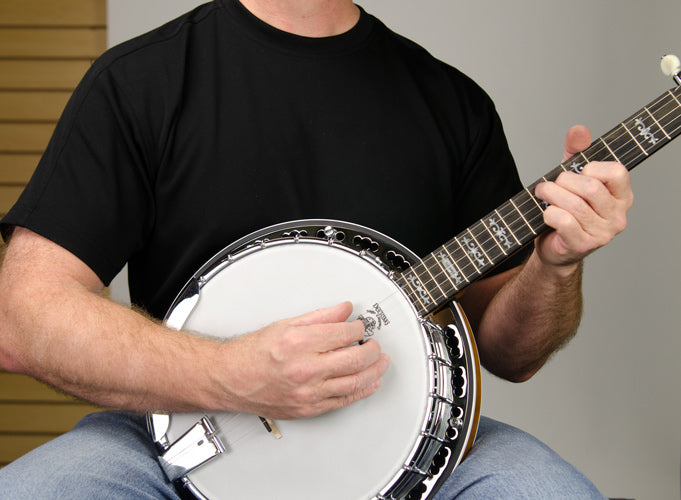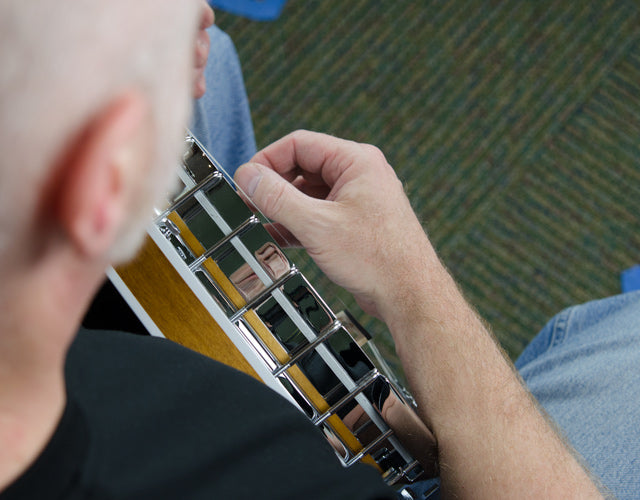Healthy Playing Technique
I’ve read and heard musician’s refer to playing a musical instrument as athletics on a smaller scale.
This is actually a pretty accurate appraisal and one that is worthwhile evaluating.
Playing the banjo is more than just using your fingers. No matter what style of banjo playing, there are physical considerations that can be helpful in fostering a healthy approach to your banjo. Because no two people are alike in the way they walk, talk, dance, sing, run, stand, sit, swim, play tennis etc, we must allow for a huge range of tolerance to allow individuals to find their own personal comfort zone. The suggestions here are not meant as “absolute” or “iron clad” or “cast in stone.”
These are mere guidelines that might aid in facilitating greater comfort while playing.
Wrist Posture
- Your wrist is usually at its most comfortable, when it is in a “neutral” position. Neutral is somewhat relative to each individual but for most players it means the wrist is not bent down or up or left or right. Because the wrist is the “tunnel” through which your tendons connect to muscles in the forearm, the “neutral” position allows the greatest freedom of movement without restriction.

- If you find your wrist bent sharply bent in any direction, it is usually best to re-position your banjo to allow a more “neutral” position. Keeping the banjo neck higher or angling the head of the banjo back so you are not reaching over the pot can help keep both left and right wrists closer to the neutral position.


Hand Posture
- Many players will find that posturing your picking hand like its holding an egg will allow your fingers to move easily and comfortably.

- Keeping your palm flat can create un-wanted tension in the fingers and palm which will slow down your potential speed and freedom of movement.

- Arching your hand too much will also extend your fingers too straight and you will lose control and strength over the strings.
Forearm, Elbow and Shoulder
The more you can allow your elbow to hang naturally down from you shoulder, the more relaxed your neck and upper back will feel.
If you can keep your elbow hanging down naturally, and position your forearm so that your wrist doesn’t bend sharply over the banjo, you will have the greatest freedom of movement possible.
Here is where it is best to move your banjo so that it accommodates you. Many players angle the face of the banjo head at a slight angle toward the ceiling and often with the neck angled up around 45 degrees.
If you keep the face of the banjo at 90 degrees to the floor and the neck parallel to the floor, like guitar players often do, you will have to bend yourself around the banjo. These angles of body bending will constrict blood flow, force your body to move in cramped positions and it will make it harder to play fast, relaxed and smooth.
Neck and Back
- It can be hard to sit up straight for long periods. Some players pace around the room while practicing rolls. They find that it’s a little easier to stand up straight than it is to sit up straight.

- We often lean our head over our banjo to “see” the fretboard, our picking fingers and the strings. This is fine, but if you sit or stand with your head bent too far over, for a prolonged period, you’re going to introduce unwanted tension and possible soreness from muscle strain.

- This is another reason to make your banjo accommodate you. Adjust your strap so that the banjo is angled up slightly, you can not only reach the strings easier, but you can see them easier.

You will eventually get to a point where you don’t have to look at your picking hand, but until that glorious day, make your banjo angled enough to minimize your neck strain.
Reaching your elbow too far away from your body can cause your upper back to strain from holding your arm in position for long periods. The angling of your banjo will minimize this reach for greater relaxation.
Practice Slow to Troubleshoot
If you practice slow, you can “feel” when your body is awkward. If you “push” yourself to play fast, your awareness gets overridden and you may not feel “where” you are feeling awkward. Typically, this develops a “tick” or “stumbling spot” in the music you are trying to play and you tend to repeat it over and over again. Now, you have “trained in a bad habit” and because you are used to “pushing past your comfort zone,” diagnosing the “trouble spot” becomes more difficult.
But, if you slow down, analyzing a bad habit gets a little easier because your awareness increases.
Slow training encourages analysis. Pushing speed discourages analysis.
Time Is A Good Teacher
If you tire quickly when you practice, analyze how you are feeling. Tense muscles and awkward repetition is exhausting. But relaxed picking can go for hours.
If you “push” yourself to practice for long hours, you must do it while you are “ergonomically comfortable.” That is, your body must be relaxed from head to toe. If your technique analysis shows you to be relaxed, you will find that your endurance is probably based more on when you get hungry or sleepy and not tired from actually playing.
You can practice tense and awkward for a while, but you will tire quickly. The longer you can play your banjo comfortably, the more relaxed your technique is and the more musical possibilities will be at your command. This is how time can “teach” you what is comfortable and what is not.
Relax and be Healthy
When you are practicing your banjo playing, think about these points:
- Practice Slow to Learn Fast.
- Fast should “feel” the same as slow; only “sound” faster. There is no more “muscle effort” needed to play fast than to play slow.
- The more relaxed your technique is, the longer you can practice.
- The longer you can practice the more skilled you become.
- Speed happens with time…. not by pushing untrained fingers with tense muscles.
Whether you are strumming, clawhammering, fingerpicking, or playing with a plectrum (flat pick), these basic concepts apply with equal importance.
You will always play better, learn better and feel better when you practice slow and focus on being comfortable.

















I am a new banjo player being 70 years of age. I have taken 4 private lessons and as bad as I want to learn I have noticed that not all picking is fast. I need to slow down and learn the banjo rolls instead of trying to go too fast. Your article brought out some interesting facts about posture which I need to pay attention to. Picking slowly and good posture will help me learn much quicker.
Thank you for your article. It will help me today to slow down and learn my rolls and my fingering.
I am a very beginner banjo player. Working through the Earl Scruggs book and cd. I continually notice that i have a hard time holding the banjo and trying to finger the notes and strum…..I am still working on the note finger as well as rolls and slides etc. I do have a strap that helps hold the banjo but most times i am readjusting the banjo to play. Any tops will be welcome. Thanks
Leave a comment